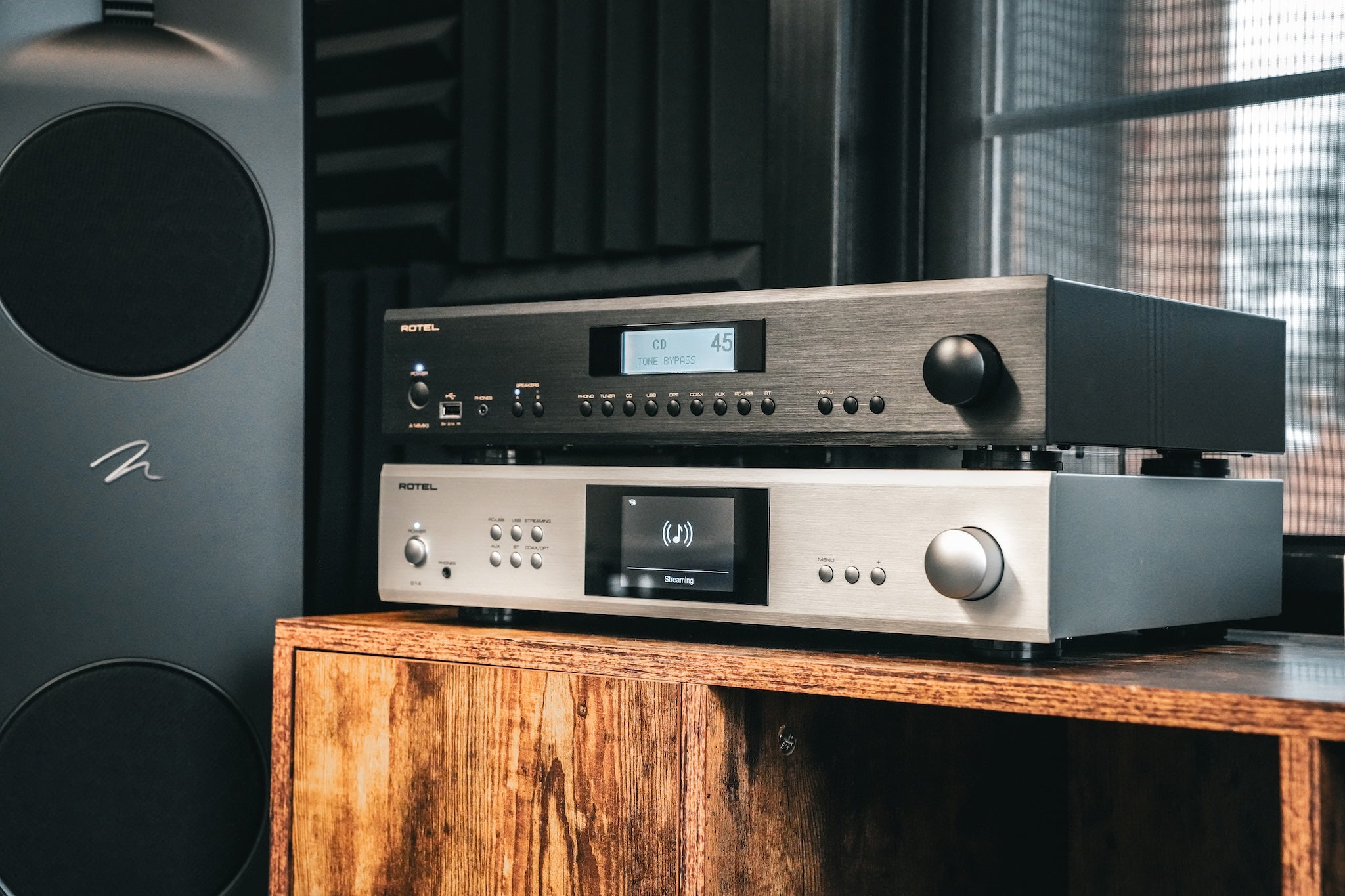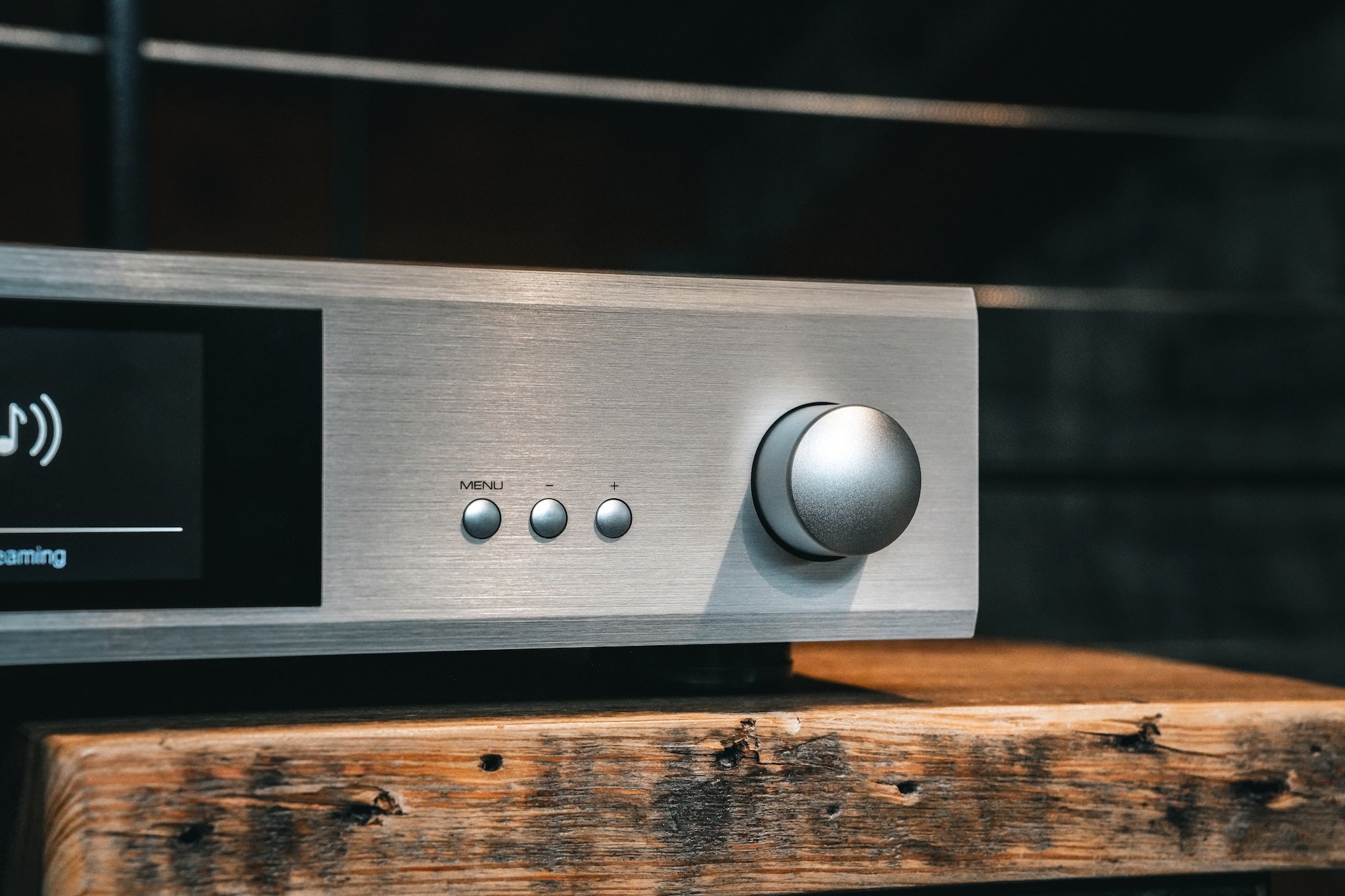Rotel has been creating innovative HiFi audio components for over 60 years, and maintains a commitment to quality in their design, component selection, and construction. That commitment resulted decades of Rotel components with world class sound and built a strong reputation for the brand. But when you’ve been around a technology focused industry for 60 years, you see a lot of changes, and need to adapt to stay relevant. With products like the new all-in-one streamer, S14, Rotel is adapting to the changing HiFi landscape. Does S14 provide a step forward for the brand, without compromising their core values?
Build and Design
While we’re used to dealing with more compact, desktop sized units intended for personal audio, S14 has the sort of girth and weight associated with high-end stereo components. Of course, while 20 pounds in the headphone space would be exceedingly heavy, compared to many integrated amps S14 is practically a featherweight. The various jacks and connections have a very industrial feeling construction that provides a high level of confidence in its durability. If someone tripped on a cable and S14 fell, I’d be more concerned about the floor than any aspect of the S14 being damaged. The screen is moderately sized and functional for displaying album artwork, but it could stand to be just a bit bigger for reading track names across the room.
The package includes power, USB and ethernet cables, a quick start guide, and a remote. S14 can accept a range of digital inputs – S/PDIF, TosLink, USB, Bluetooth, Ethernet, WiFi – and has a single analog input via RCA. There’s also an option to connect a USB thumbdrive, but the capacity is limited to 32GB, and playback control is only possible through the app (otherwise the songs can will be played back sequentially in alphanumeric order.) For output, you have a preamp RCA output and a subwoofer connection, along with rear connectors that are good for either banana or bare wire hookups.
Interface and Features
Most of the device functions can be accessed via the front panel on the device or the included remote. For the most part you just need to attach a source to the specified input, select that source, and you’re good to go. There is no output selection, so S14 will output to whatever is connected: pre, sub, speakers, or all of them.
For WiFi setup S14 doesn’t have its own configuration, but instead can use either Apple AirPlay or Google Chromecast setup from your phone to connect as a wireless device. Once the WiFi is connected, you can also use S14 as a Roon Endpoint or stream wireless on Spotify Connect. Direct Qobuz support is also available through the Rotel app. The Rotel app has some basic functions and controls, but doesn’t provide much more than the ability to stream from internet radio and Qobuz. The other function of the app is that if you’ve connected a USB thumb drive to the USB port, you can control playback stored on the drive.
There are a number of configuration options available including DAC filters, basic EQ and balance controls, and other power and protection related options. The default configuration prioritizes preservation of your gear (and ears) with settings like “Power On Max Volume” set conservatively out of the box. The Power On Max Volume will also reset if you change sources or even switch from say, Qobuz Streaming to Spotify Connect, so if you’re jumping around a lot, keep the remote handy to adjust the volume.
The app and interface are functional, utilitarian, and definitely get the job done, but they do feel a little dated compared to competitive products from newer brands. I can’t emphasize enough though that – while I wasn’t as impressed by the screen or interface choices as I have been in other devices – every worked as expected and as outlined in the manual, and the communication stability was excellent for streaming. And of course, while design choices that look great today may feel dated tomorrow, great sound is timeless.
Sound
Depending on what you need, S14 can be an all-in-one – streamer, DAC, and amplifier – or it can work as a DAC and Streamer to feed your signal to a more powerful amp. It does have a headphone output as well, which provides added flexibility for a desktop setup, but I wouldn’t recommend purchasing S14 solely to use for headphones.
Compared to other streamer options we've tested, S14 used solely as a streamer and DAC is a solid pick at $2499. The network performance was excellent in our environment, and the variety of inputs is useful for complex setups. The only shortcoming of note here was that S14 lacks an option to bypass the DAC so that you can upgrade the DAC and amplifier components separate from it's streaming features.
As an all-in-one, S14 is surprisingly capable, boasting a maximum of 150W of power: more than enough for a wide range of bookshelf and floorstanding speakers. S14 delivers a little extra energy in the bass, and provides a nice, airy upper end. The midrange took a little bit of time to really come to life, but in the end, the result was a rich, full, detailed sound, with solid imaging presentation. In fact, the longer I sat and listened to S14, the more impressed I was. Even using lower quality streams from Spotify, S14 delivered a highly lifelike, engaging presentation.
Running S14 through the requisite reference tracks, it demonstrated all the key characteristics you’re looking for: a visceral physical weight to the deep bass hits with Daft Punk, a spacious stage and emotional guitar with Dark Side of the Moon, and a “close your eyes and you’re in a jazz club 1957 with a cigar in one hand and a glass of bourbon in the other” sensation with Blue Train.
The real “stop and take note” moment in my listening came when I pulled up a recent recommendation from a friend, Angie Haze’s “Beneath the Dirt,” a minimalist track driven primarily by the vocal arrangement. The combo of S14 and MartinLogan brought an intensity and realism to the vocals that I wasn’t ready for. Perhaps the unfamiliarity played a part, but this was the biggest, “hair on the back of your neck standing up” moment of my time with S14.
Using S14 as the DAC/Stream and A14 MKII as the amp provided more dynamic energy and stronger separation specifically notable with the MartinLogan XT F200 floorstanding set. Due to the similar specs, I was a little surprised that I preferred the amplifier section of A14 MKII over S14, but whatever the small differences in the signal path may be, using S14 as a DAC/Streamer, and A14 as the amplifier add to the sense of weight in the stereo image and enhanced the general sense of three-dimensionality in the instrument placement.
The other integrated amp I tried out was the AVM A 6.2 ME, which is a couple steps above the S14 and A14 in price and performance. The AVM was the clear choice for our Canton Reference 7k, which neither of the Rotel options felt 100% equipped for. In terms of the pairing and synergy, rather than leaving S14 outclassed compared to more expensive DAC options, the S14 scaled up beautifully when bolstered by the AVM, delivering a fuller, richer, more holographic image, with stronger dynamics and resolution.
The Bottom Line
S14 isn’t a revolutionary or wholly unique product, but it demonstrates Rotel’s commitment to excellence in the fundamentals of performance and design while adapting the changing HiFi landscape. At $2499, the ability to plug in it and add speakers for instant HiFi bliss, coupled with DAC and Streamer performance that can scale with very high-end components makes S14 the perfect piece if you’re just starting out in 2-channel HiFi, and a great choice for adding a digital component to an existing analog system.









